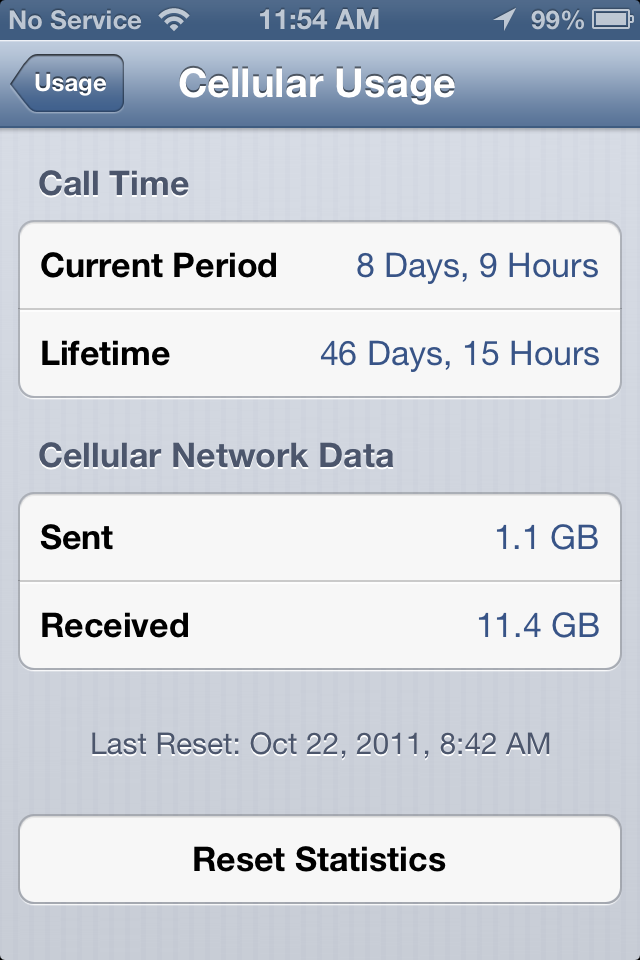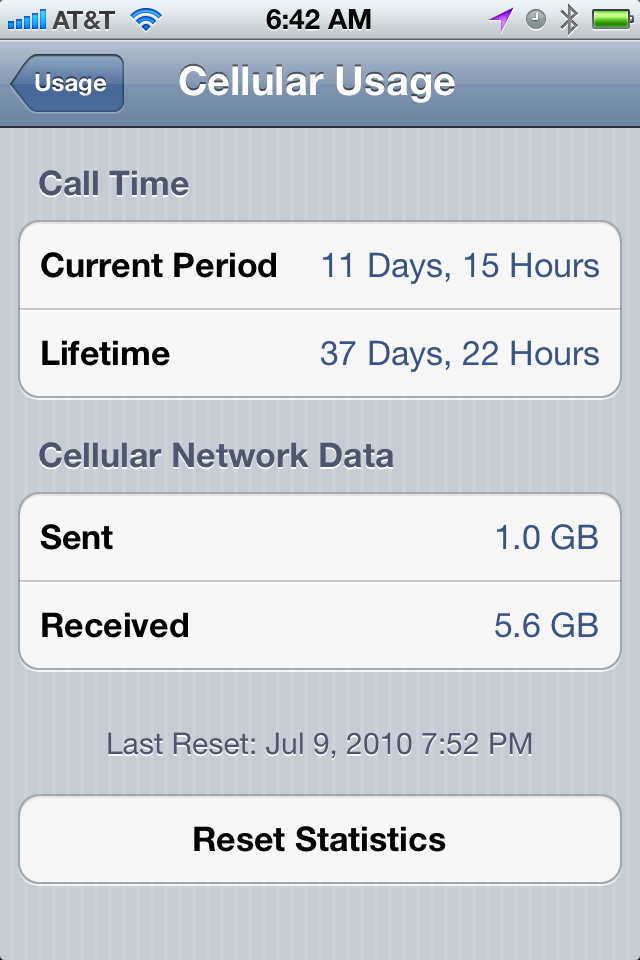iPhone 4S Cellular Usage Stats

My iPhone 4S cellular data usage stats from October 22, 2011 to September 22, 2012.
I used 11.4 GB of data in 336 days, or about 34 MB/day. For comparison, I used about 14 MB/day on my iPhone 4.
This continues the trend of increasing data usage with each new device, but the jump from the 4 to the 4S is the largest jump I’ve seen so far (2.4x increase in daily usage). I would attribute the large increase do to my the amount of traveling I did this year. Without WiFi, I relied on my phone quite a bit, especially in countries where tethering was allowed.
See here for my iPhone 4 data usage.
See here for my 3GS data usage.
See here for my 3G data usage.
See here for my original iPhone data usage.
Living Without The iPad
Matt Alexander, on what he came to realize after living a few weeks without an iPad:
The iPad is a means for productivity, entertainment, and communication - it encompasses the tasks we have so often spread across mediums into one centralized and fantastic location. But, in doing so, the door is open for inadvertent and helpless absorption into its environment. Into allowing oneself to reach for the iPad when you would otherwise be open for valuable thinking, reading, writing, and whatever else may be of importance to you.
Sent from my iPad
The "Disappointing" iPad 3
Marco Arment, writing about speculation that the iPad 3 will be disappointing, even before anyone has seen it:
Knowing no more than you do right now, I can guarantee you: the iPad 3 will disappoint a lot of armchair tech commentators, “analysts”, and anyone who gets paid by the pageview. (How convenient.)
We see this “disappointing” talk from many of the old-timers because they’ve spent 25 years writing about specs and that’s the lens they use to look at the iPad. “It’s not getting a quad-core processor? Android tablets have quad-core chips. How disappointing.”
They don’t care that Apple and third parties ship software that utilizes both cores (iMovie, GarageBand) and that hardly anyone ships Android software that utilizes more than one core, much less all four. They don’t care that Apple may have tweaked last year’s dual-core chip to get better performance and better battery life. According to them, since 2=2 and 2 < 4, the iPad 2 is a lackluster upgrade and is empirically worse than an Android tablet.
Meanwhile, 50 million people couldn’t care less what’s inside an iPad. All that matters is that the hardware and software work together to make a delightful experience. Just look at what Om Malik wrote about giving his iPad 2 to his mother in India:
It didn’t matter how it was happening — just that she could talk to her grandson who was oceans apart from her. If there ever was a moment that captured the emotion in a piece technology, that was it. The look on her face made me realize how lucky I am to write about an industry that makes such things possible. I also thought to myself, maybe somewhere Steve Jobs is smiling too.
Like I said before: It’s not about what it is. It’s about what it does.
Microsoft's Halo Effect Opportunity
There have been reports over the past few weeks that Microsoft is working on a version of Office for the iPad. The main downside most think of to selling an iPad Office suite is that Office is the missing piece to the iPad puzzle and that enterprises will flock to the iPad in lieu of Windows 8 tablets once Office becomes available. There are two issues with this scenario: (1) the iPad is doing fine in the enterprise without Microsoft’s help; and, (2) Microsoft shouldn’t care if they make $15 off of Office for iPad or a Windows 8 license.
Office for iPad actually presents Microsoft with a great opportunity. It’s no secret that Windows Phone 7 reviews well but doesn’t sell well. Part of it has to do with a weak marketing effort on Microsoft’s part, but a lack of enthusiasm among frontline sales reps plays a huge role as well. The average consumer walks into a carrier store knowing about the iPhone, but may be swayed to pick up an Android handset at the salesperson’s behest (which in turn is driven by incentives). Windows Phone never enters the conversation.
Windows 8’s Metro interface is reviewing well, as Gruber mentions in a link to Christian Cantrell’s review of Windows 8 Consumer Preview, but again, Microsoft faces a perception problem. iPads and Macs are eating up PC sales, and so many won’t even give Windows 8 a shot.
Now imagine a world where the average consumer walks into the store knowing about the iPhone and having been wowed by Office for iOS’s Metro interface. Office for iOS isn’t going to push Windows Phone to #1 or #2, but at least Microsoft will be back on the radar. Even if users have already chosen the iPad for their tablet, an Office/Metro halo effect can drive those iPad users to Windows PCs and phones.
Along those lines, an iOS version of Office also allows Microsoft to establish a foothold with their own ecosystem – particularly their cloud storage solution, SkyDrive. If a user becomes dependent on Office for iOS and ends up storing all their documents on their personal SkyDrive or their company’s SharePoint server (because that’s all Office for iOS supports), they will likely seek out a PC solution that’s compatible with what they currently have. So would they rather go with a Mac, whose version of Office is usually a year or two behind the Windows version and never offers the same exact features, or go with Windows, whose version of Office receives first-class support from Microsoft and uses that cool Metro interface that they wish all of iOS had?
iPhone 4 Cellular Usage Stats

My iPhone 4’s usage stats from July 9, 2010 to October 12, 2011.
I used 5.6 GB in 410 days (460 days minus 50 days spent out of the country for work), or about 13.6 MB/day. For comparison, my iPhone 3GS used 3.1 GB in 381 days, or 8.13 MB/day.
It’s not quite the doubling I saw when going from 1st Gen to 3G or 3G to 3GS, something I would attribute to iOS 5, which I’ve been running since the early summer. I always had WiFi off prior to iOS 5, but with the new wireless syncing feature, I am using WiFi exclusively at home and at work and only dropping down to 3G when I’m not at either.
In contrast, I got my 4S Saturday morning and was out of town until Sunday afternoon. The usage counter on the 4S reads 53.4 MB, or about 25.7 MB/day.
See here for my 3GS data usage.
See here for my 3G data usage.
See here for my original iPhone data usage.